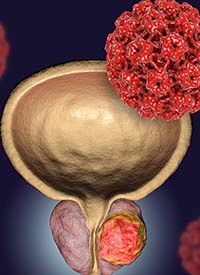Article
BMI Is a Significant Predictor for Survival in mCRPC
Author(s):
Obese men with metastatic castration-resistant prostate cancer have better disease-specific and overall survival than overweight or normal weight patients.

Obese men with metastatic castration-resistant prostate cancer (mCRPC) have better disease-specific and overall survival (OS) than overweight or normal weight patients, according to results from an analysis of three phase 3 clinical trials that were presented during the 2021 American Urological Association Annual Meeting.1
“The BMI effect on cancer-specific mortality was also confirmed about as a continuous and as a categorical variable,” said study coauthor Giuseppe Ottone Cirulli, MD, a urology resident of Vita-Salute San Raffaele University in Milan, Italy. “Additionally, the protective effect of BMI is not related to the higher dose of chemotherapy.”
Cirulli said that prior data have demonstrated the correlation between BMI and survival outcomes in prostate cancer. In this study, investigators sought to determine whether BMI among patients with mCRPC is associated with OS and disease-specific mortality.
Investigators identified 1577 patients in the ASCENT2 (NCT00273338), MAINSAL (NCT00988208), and VENICE (NCT00519285) trials, 655 of whom had died by the end of the studies. The median follow-up for survivors was 12 months. The Cox semi-proportional hazard model was utilized to predict for OS, while the competing risks regression was utilized to predict for cancer-specific mortality.
There were adjusted analyses for age, prostate-specific antigen, ECOG, number of metastasis, and prior therapy.
The median age was 69 years, and the median BMI was 28 kg/m2. Investigators analyzed the role of BMI on survival outcomes both as a continuous and categorical variable (<20 vs 20-25 vs 25-30 vs >30 km/m2). A BMI of 30 kg/m2 or greater was considered obese.
BMI emerged as a protective factor for OS both as a continuous variable (HR, 0.96; P = .015) and as a categorical variable (HR, 0.71; P = .027). Similarly, BMI’s effect on cancer-specific mortality was confirmed both as a continuous (HR, 0.94; P = .002) and as a categorical variable (HR, 0.65; P = .018).
Cirulli and colleagues selected patients from ASCENT2, MAINSAL, and VENICE because all 3 included men with mCRPC treated with docetaxel. Chemotherapy dose is determined in part by weight, but investigators determined there was no interaction between the BMI categories and the docetaxel dose (all P >.05).
In ASCENT2, patients were randomly assigned to 45 μg DN-101, 36 mg/m2 docetaxel, and 24 mg dexamethasone weekly for 3 weeks of a 4-week cycle (n = 476) or 5-mg twice-daily prednisone plus 75 mg/m2of docetaxel and 24 mg dexamethasone every 3 weeks (n = 477).2
The median follow-up for patients alive at last assessment was 11.7 months. The median OS was 17.8 months (95% CI, 16.0-19.5) in the experimental arm and 20.2 months (95% CI, 18.8-23.0) in the control arm (log-rank P = .002). Survival remained poorer in the experimental arm even after adjusting for baseline variables (HR, 1.33; P = .019).
In MAINSAL, chemotherapy-naïve patients with progressive mCRPC were randomized to 75 mg/m2 docetaxel on day 1 and 5 mg twice-daily prednisone on days 1 to 21 and either 25 mg once-daily lenalidomide (n = 533) or once-daily placebo (n = 526) on days 1 to 14 of each 21-day treatment cycle.3
The median OS was 17.7 months (95% CI, 14.8-18.8) in the lenalidomide group and was not reached in the placebo group (HR, 1.53; 95% CI, 1.17-2.00; P = .0017). The trial was subsequently closed early due to futility.
In VENICE, 1224 chemotherapy-naïve patients with adequate organ function were assigned to 75 mg/m2docetaxel every 3 weeks plus 5 mg twice-daily oral prednisone (5 mg twice daily). They were then randomly allocated to 6 mg/kg of aflibercept (Eylea; n = 612) or placebo (n = 612) every 3 weeks. Results showed that the median OS was 22.1 months (95.6 CI, 20.3-24.1) in the aflibercept group vs 21.2 months (95.6% CI, 19.6-23.8) in the placebo group (HR, 0.94; 95.6% CI, 0.82-1.08; P = .38).4
References
- Martini A, Cirulli GO, Gandaglia G, et al. The obesity paradox in metastatic castration resistant prostate cancer. Presented at: the 2021 American Urological Association Annual Meeting; September 10-13, 2021; virtual. Abstract PD05-01.
- Scher HI, Jia X, Chi K, et al. Randomized, open-label phase III trial of docetaxel plus high-dose calcitriol versus docetaxel plus prednisone for patients with castration-resistant prostate cancer. J Clin Oncol. 2011;29(16):2191-2198. doi:10.1200/JCO.2010.32.8815
- Petrylak DP, Vogelzang NJ, Budnik N, et al. Docetaxel and prednisone with or without lenalidomide in chemotherapy-naive patients with metastatic castration-resistant prostate cancer (MAINSAIL): a randomised, double-blind, placebo-controlled phase 3 trial. Lancet Oncol. 2015;16(4):417-425. doi:10.1016/S1470-2045(15)70025-2
- Tannock IF, Fizazi K, Ivanov S, et al. Aflibercept versus placebo in combination with docetaxel and prednisone for treatment of men with metastatic castration-resistant prostate cancer (VENICE): a phase 3, double-blind randomised trial. Lancet Oncol. 2013;14(8):760-768. doi:10.1016/S1470-2045(13)70184-0









